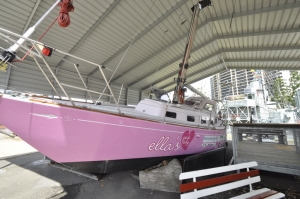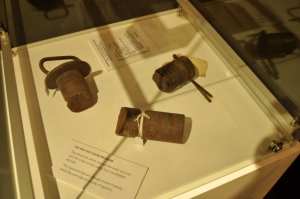Tradition and technology have been part and parcel of our world’s maritime history. Different cultures, changing ocean environments, and diverse uses and purposes influence the design, technology, capacities and utility of ships and boats in general, over the centuries.
The yonder days of lighthouses, octants and sextants, and mechanical chronometers are now encapsulated into time machines we call museums.
For Queensland, maritime history is integral because of the vast coastline and the hazardous Great Barrier Reef. The Queensland Maritime Museum (QMM) is home to this rich maritime history.
Features at QMM
There are several ongoing events and exhibitions that provide significant information and insights about certain points in history. Built Beneath The Bridge is an exhibit that tells the story of Evans Deakin Shipbuilders, a significant Brisbane engineering firm, through photographs and models from the Museum’s collection. This includes the story of how “The Pin” saved Brisbane—the actual pin itself is on display.
Among the navigational aids in the past, lighthouses are always fascinating facets of history—maritime or otherwise. The Lighthouse Gallery at QMM shows the evolution of lighthouse lamps from the earliest oil wick burners, kerosene and acetylene-powered lights through to an early laser light and currently used equipment. It shows the principles of the Fresnel lens and how mariners many kilometres away can see a flame in a kerosene lamp.
QMM CEO Ian Jempson offers an insight into how modern-day navigation practices by recreational boaties have evolved. “Smart mariners use everything at their disposal: eyes, charts, compass, echo sounders.” GPS has become the sole technology of source by most recreational boaties, but it must be remembered that GPS is “garbage in, garbage out” technology.
Famous boats and ships are on display, including Forceful, Fury and Ella’s Pink Lady. Built in 1925 by Alexander Stephen & Sons Ltd of Govan, Glasgow, Scotland, Forceful served the port of Brisbane for 45 years, being the last coal-fired tug in operation. Fu ry, a skiff-class dinghy, was built in 1937 by Norman Wright & Sons of Bulimba, Brisbane. Its 4.88m (16ft) hull is of batten-seam construction, the normal method used for the class at the time, and it is rigged with a high-peaked gunter mainsail. Ella’s Pink Lady is a Sparkman & Stephens 34-foot yacht, well respected for her seaworthiness, resilience and track record. The Pink Lady is part of sailing history after Gold Coaster Jessica Watson made history as the youngest person to sail solo and unassisted around the world in 2009/10.
ry, a skiff-class dinghy, was built in 1937 by Norman Wright & Sons of Bulimba, Brisbane. Its 4.88m (16ft) hull is of batten-seam construction, the normal method used for the class at the time, and it is rigged with a high-peaked gunter mainsail. Ella’s Pink Lady is a Sparkman & Stephens 34-foot yacht, well respected for her seaworthiness, resilience and track record. The Pink Lady is part of sailing history after Gold Coaster Jessica Watson made history as the youngest person to sail solo and unassisted around the world in 2009/10.
The most iconic and biggest in the collection is the WW2 frigate HMAS Diamantina, built in Queensland and commissioned in 1945, and now the last remaining WW2 River Class frigate in the world. One of its main features is the cavity magnetron. In early 1940, Australian physicist Mark Oliphant and his team designed the cavity magnetron, which became one of Britain’s most closely guarded wartime secrets. With its cavity magnetron, the Type 271 radar had range and bearing discrimination small enough to detect small objects such as surfaced submarines and, in good weather, submarine periscopes. This type of radar was ideal for smaller warships like Diamantina tasked with protecting convoys and anti-submarine warfare. Interestingly, the cavity magnetron is also the “heart” of a household appliance—the microwave oven.
As an intact wartime vessel, complete with its machinery and equipment, Diamantina has outstanding interpretive capacity: providing dramatic evidence of the workings of a warship and the conditions under which its personnel lived and worked. The ship also has scientific significance in marking an important transition in modern warship design, and for the evidence it provides of the development of radar and oceanography. (According to Jempson, it was through the research conducted on Diamantina that scientists have concluded that it is the Indian Ocean that affects Australian climate and has an impact on climate change.) Finally, Diamantina has spiritual significance for the descendants of hundreds of Australians who once served in the ship, particularly for those who were christened aboard.
The QMM also offers a vast range of marine and maritime artefacts from the “large-size, the HMAS Diamantina, down to small, the 1890 kayak, and much in between,” states Jempson. “The South Brisbane Dry Dock is an important heritage artefact and quite amazing to stand at the bottom of it. It is a rare opportunity worldwide.”
Volunteer organization
More interesting to one’s visit is meeting the volunteers who help in the maintenance of the boats on display, and who also conduct boat-building activities at the workshop.
As a volunteer-based organisation, QMM encourages younger people to get involved. “Established in 1971, the QMM is a credit to the 40 plus years of hard work by our fabulous group of volunteers and donors. In recent years, we have enjoyed very good assistance from a younger group of volunteers. There are challenges attracting volunteers and plenty of competition,” relates Jempson. “Following attendance at our Pirates Week earlier in 2015, a young participant who had enjoyed himself was heard telling his parent that he was going to become a volunteer at QMM when he grows up. Community-wide, I think we need to plant the seed in our children that you do not have to be grey-haired to be a volunteer.”
Why should recreational boaties drop by for a visit at QMM? Jempson provides the reasons: “The wide diversity of craft on display, the craftsmanship of the boat builders, and the opportunity to relate to the experience of other mariners.” It is also great fun for the whole family!
By Roselle Tenefrancia
The Pin That Saved Brisbane: The Robert Miller (239m long, 15m high and 66,703 tonnes) was at Kangaroo Point during the Brisbane 1974 floods and may have caused much more dam age if she had blocked the river flow. In the journey downriver the shorter anchor cable ran out to the end, the pin sheared and fell out and the anchor cable dropped into the river. The ship, after this momentary check, again gathered way until checked by the other anchor cable running out to the “bitter” end. The shear pin snapped, but the two halves did not jump out as was designed and the last link of the anchor chain jammed in the bitter end bracket, and held the bow of the ship against the force of the flow of the river.
age if she had blocked the river flow. In the journey downriver the shorter anchor cable ran out to the end, the pin sheared and fell out and the anchor cable dropped into the river. The ship, after this momentary check, again gathered way until checked by the other anchor cable running out to the “bitter” end. The shear pin snapped, but the two halves did not jump out as was designed and the last link of the anchor chain jammed in the bitter end bracket, and held the bow of the ship against the force of the flow of the river.
Lighthouse highlight: The Benard & Barbier pedestal (circa 1897) is thought to be the sole remaining example worldwide of one of the first electrically driven pedestals. 



























